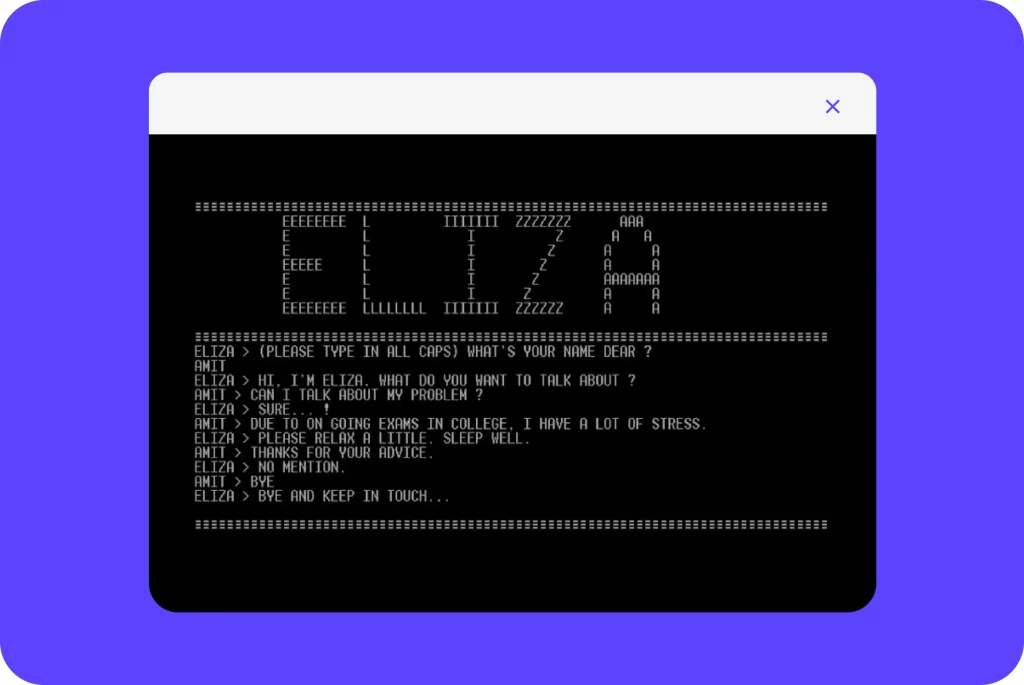Chatbots are integral to our digital landscape, quietly assisting us in myriad tasks, answering questions, and even providing companionship. Yet, their history, a fascinating journey from Eliza to the sophisticated AI-powered conversational agents of today, often goes unnoticed. In this article, we embark on an engaging exploration of the history of chatbots.
We’ll trace their evolution, from the early days of Eliza, through significant milestones to the advanced AI chatbots reshaping our digital interactions. Along this journey, we’ll uncover the pivotal moments that have transformed these virtual conversational agents into indispensable tools while ensuring the content remains accessible and intriguing.
Related must-reads:
- How to create a chatbot – Best practices to follow in 2023
- Future of Chatbots: Key Trends to Watch in 2023!
- Enterprise Chatbot – A Guide for Enterprises [2023]
- Benefits of AI Chatbots for Businesses and Customers
The birth of Eliza (1960s)
The chatbot journey kick-started in the 1960s with the birth of Eliza. Eliza stands out as one of the earliest and most influential chatbot programs. Joseph Weizenbaum conceived it at the Massachusetts Institute of Technology (MIT) during the mid-1960s. The goal was to simulate conversations akin to those with a Rogerian psychotherapist.

Eliza relied on basic pattern-matching techniques to react to user inputs. It offered therapeutic responses that often rephrased the user’s statements as questions. Eliza’s conversational abilities were rather rudimentary for the era. Furthermore, its language comprehension left room for improvement. However, it undeniably showcased the potential for computer programs to engage in human-like interactions.
The Turing Test and Parry (1970s)
The Turing Test became a pivotal yardstick in the 1970s as chatbot technology advanced. This test was devised by the British mathematician and computer scientist Alan Turing in 1950. The primary objective was to evaluate whether a machine could demonstrate intelligent behavior indistinguishable from a human’s.
In the early 1970s, Kenneth Colby introduced another influential chatbot named Parry. Parry’s purpose was to simulate an individual who has paranoid schizophrenia. It aimed to underscore the potential of natural language comprehension in psychiatric diagnosis. While it didn’t achieve commercial success, Parry’s development paved the way for more sophisticated chatbots in the future.
The rise of text-based chatbots (1980s and 1990s)
The 1980s and 1990s witnessed the emergence of text-based chatbots, often tailored for specific functions like customer support and information retrieval. These chatbots primarily relied on rule-based systems, operating on predefined scripts to generate responses.
An illustrative example from this period was Dr. Sbaitso, bundled with Creative Labs’ Sound Blaster audio cards in the early 1990s. Dr. Sbaitso acted as an interactive assistant, engaging users in text-based conversations and even capable of converting text into synthesized speech.
Aimee and ALICE (1990s)
The late 1990s introduced more advanced chatbots like Aimee and ALICE. Aimee, crafted by A.L. Hutchings in 1996, was tailored to replicate the experience of conversing with a teenage girl. It marked a more sophisticated approach to natural language comprehension and generated responses that bore a closer resemblance to human speech.
ALICE, short for Artificial Linguistic Internet Computer Entity, entered the scene in 1995, marking another significant milestone. ALICE adopted a rule-based methodology and maintained a vast database of patterns and responses to engage in conversations. Its claim to fame was its participation in the Loebner Prize Turing Test, an annual competition evaluating conversational AI.
The emergence of commercial chatbots (2000s)
The 2000s witnessed the dawn of commercial chatbots. As the internet expanded, so did the demand for automated customer support and online assistance. Companies recognized the potential of chatbots in engaging with customers on websites, offering swift responses to frequently asked questions.
During this era, one notable commercial chatbot stood out – SmarterChild. It was introduced by ActiveBuddy, later acquired by Microsoft, in 2001. SmarterChild seamlessly integrated into various instant messaging platforms, including AOL Instant Messenger and MSN Messenger. Its capabilities extended to providing real-time weather updates, delivering the latest news, and offering general information.
Cleverbot 2006
The year 2006 witnessed the birth of Cleverbot, conceived by Rollo Carpenter. Cleverbot gained recognition for its engaging and often whimsical interactions with users. Differing from task-specific bots, Cleverbot thrived on free-form and natural conversations. It continually learned and honed its responses through user interactions.
Originally designed with the intent to pass the Turing Test, Cleverbot has since evolved into a captivating experiment in artificial intelligence. Users can engage with Cleverbot via its website or various messaging platforms. That makes it a compelling example of the evolution and capabilities of conversational AI.
The advent of Siri and voice assistants (2010s)
In the 2010s, a monumental shift occurred in the chatbot landscape with the advent of voice-activated virtual assistants. Leading the way was Apple’s Siri, introduced in 2011, which marked a pivotal moment in chatbot development. Siri harnessed the power of natural language processing and machine learning to grasp and promptly respond to voice commands, setting an entirely new standard for conversational AI.
Following suit, other tech giants entered the arena. Amazon unveiled Alexa, while Google introduced Google Assistant. These voice-activated assistants expanded the horizons of chatbots, allowing users to effortlessly control smart devices, enjoy music, and execute an array of tasks using everyday language.
Cortana: A multifaceted virtual assistant
Cortana, Microsoft’s brainchild introduced in 2014, emerged as an intelligent personal assistant. Its journey began as part of Windows Phone 8.1 but quickly extended its presence to various platforms, including Android and iOS, ensuring accessibility for users across the digital landscape.
Named after the AI character in the Halo video game series, Cortana embodies a wide range of capabilities. These encompass voice-activated commands, reminders, calendar management, and real-time weather updates. Notably, it goes beyond the basics, fielding general knowledge queries, tracking packages, and suggesting nearby restaurants and attractions.
Cortana’s seamless integration with Microsoft’s expansive suite of productivity tools sets it apart. This tight-knit collaboration extends to Microsoft 365 and Windows 10, enriching the user’s overall digital experience.
Yet, Cortana isn’t without its challenges. Over time, it has encountered fierce competition from virtual assistants like Amazon’s Alexa, Google Assistant, and Apple’s Siri. In response, Microsoft announced a strategic shift in 2021, repositioning Cortana from a consumer-oriented personal assistant to a productivity-enhancing tool within the Microsoft 365 ecosystem.
As Cortana continues evolving, it remains a significant player in the virtual assistant domain. It offers users an intelligent and integrated solution for managing tasks, accessing information, and elevating overall productivity within the digital realm.
Rise of AI-powered chatbots (2010s and beyond)
The 2010s marked a transformative era for chatbots. During this decade, artificial intelligence and machine learning began to shape them. Indeed, this period initiated the history of AI chatbots.
Chatbots soon acquired the ability to manage intricate conversations. They benefited from the power of neural networks and deep learning. These technologies refined their language capabilities.
Facebook’s introduction of the Messenger Platform in 2016 was pivotal. This platform empowered businesses to create chatbots within Messenger. Consequently, a fresh chapter in chatbot evolution began. Many enterprises utilized these AI tools for various tasks, including customer service and e-commerce.
Simultaneously, Microsoft unveiled Tay on Twitter in 2016. Tay was designed to converse and adapt through user interaction. Unfortunately, Tay’s susceptibility to negative manipulation was quickly evident. It highlighted the urgency for ethical AI development.
Chatbots in healthcare and mental health (2010s and 2020s)
Lately, the healthcare sector has seen chatbots play a significant role. These bots offer vital patient information, reminders, and even therapeutic dialogue. Woebot stands out in this context, assisting users battling stress and anxiety through AI-driven therapy.
Chatbots proved especially vital during the COVID-19 crisis. They disseminated crucial information and fielded virus-related inquiries. Consequently, they relieved stress from healthcare workers and helplines, aiding in pandemic management.
Modern chatbots: GPT-3 and beyond
GPT-3 (Generative Pre-trained Transformer 3), introduced by OpenAI in 2020, revolutionized chatbot tech. It boasts 175 billion parameters and is an immensely powerful language model. Thanks to this scale, GPT-3 can produce incredibly human-like text.
Chatbots powered by GPT-3 can engage in remarkably sophisticated conversations. They can craft essays, generate code, and even facilitate language translations, among many other tasks. However, the capabilities of these chatbots have raised profound ethical and societal questions concerning potential misuse, necessitating regulatory considerations.
Ethical considerations and challenges
The chatbot journey brings forth many ethical dilemmas. With chatbots becoming more realistic and skilled in mimicking humans, issues arise. Risks like misinformation, bias, and privacy breaches have become prominent.
To combat these issues, developers and researchers are proactive. They’re channeling their efforts towards ethical AI practices. Their goals include establishing guidelines and ensuring transparency in chatbot operations.
Future trends in chatbots
The future of chatbots holds exciting possibilities. Here, we delve into some of the trends and developments to anticipate:
- Multimodal Chatbots: These chatbots adeptly transition between text, voice, and visual interfaces, creating immersive interactions.
- Emotional Intelligence: The next frontier in chatbots involves recognizing and responding to users’ emotions, elevating interactions to be more empathetic and human-like.
- Hyper-Personalization: AI-driven chatbots offer highly personalized recommendations and assistance, leveraging user preferences and behavior for tailored experiences.
- Integration with Augmented Reality (AR) Chatbots: The fusion of chatbots with AR promises innovative and engaging user experiences.
The impact of AI chatbots from Yellow.ai
Yellow.ai‘s AI chatbots offer transformative benefits to businesses. A primary advantage is their ability to enhance customer support. These chatbots operate around the clock, offering customers consistent help. Consequently, customer satisfaction soars.
Additionally, these chatbots are adept at quick problem-solving. They analyze customer issues rapidly and provide solutions. As a result, customers face reduced wait times and fewer errors. This efficiency leads to notable cost reductions. Companies can then cut back on large customer support teams, reallocating their resources more effectively.
The scalability of AI chatbots is also impressive. They handle many conversations at once, adapting to varying support needs. Their consistent responses uphold the brand’s image and mitigate the spread of misinformation.
Furthermore, Yellow.ai chatbots come with multilingual support. They’re tailored for personal interactions and are skilled in gathering crucial customer insights. Such capabilities position them as vital tools. They optimize customer engagement, streamline operations, and drive informed business decisions.
AI chatbots: Limitless possibilities
The chatbot journey highlights their metamorphosis into multifunctional assets. They now touch various industries. Let’s delve into a few sectors where chatbots shine.
1. Manufacturing and supply chain management
In manufacturing, chatbots have become indispensable. They aid in inventory checks, fine-tune production schedules, and boost order tracking. As a result, companies see better efficiency, cost reduction, and prompt deliveries.
2. Customer support and service
Here, chatbots show their true worth. They offer quick technical help, manage warranty claims, and retrieve information adeptly. It improves customer relations, speeds up issue resolution, and enhances satisfaction levels.
3. Healthcare
Chatbots serve multiple roles in healthcare. They handle appointment bookings, assess symptoms, and remind about medications. Besides improving patient experiences, it also contributes to better healthcare management.
4. Retail and E-commerce
Chatbots significantly influence these sectors. They suggest personalized products, track orders, and act as virtual shopping guides. By doing so, they lift user engagement, enrich the buying experience, and amplify sales.
5. Energy and utility companies
These firms are leveraging chatbots more and more. The bots manage billing, report outages, and monitor energy use. It fosters easier customer interactions, cuts down costs, and guarantees effective service.
6. Human resources departments
HR departments in various industries employ chatbots for recruitment, onboarding, and employee support. Chatbots facilitate these processes, making them more efficient and less labor-intensive.
7. Automotive industry
For vehicle owners, chatbots offer vital insights. They diagnose, provide maintenance tips, and elevate the car ownership journey.
8. Finance and banking sectors
Banks and financial entities utilize chatbots extensively. These bots oversee accounts, dispense loan details, and guide on personal finance. They make financial dealings smoother, enrich customer experiences, and aid fiscal planning.
9. Agriculture
Surprisingly, even agriculture benefits from chatbots. They help monitor crops, advise on equipment, and refine farming methods. Consequently, farmers witness better yields and more streamlined operations.
10. Pharmaceutical industry
In pharma, chatbots spread vital drug data and ease clinical trial enrollments. It ensures patients receive correct medication info and bolsters medical research.
Overall, the versatility of chatbots is evident. They enhance processes, client relations, and efficiency across diverse sectors.
NLP’s role in chatbot evolution
Natural Language Processing (NLP) is crucial to chatbot evolution. It’s a linchpin that connects chatbots’ past to their current abilities.
In the early days, chatbots relied on basic, rule-based answers. Now, they’ve matured into context-aware systems. In this transformation, NLP has played a crucial role. It equips chatbots to understand human speech, grasp what users mean, and reply in a natural manner.
Thanks to NLP upgrades, chatbots have come a long way. Pioneers like ELIZA and ALICE laid the foundation. Today’s AI chatbots, such as those by Yellow.ai, have raised the bar. They can hold conversations that feel human-like. Additionally, they excel in customer support and find use in multiple sectors.
In essence, NLP’s ongoing integration has made chatbots invaluable. Businesses and industries globally depend on them. It has fundamentally changed how we engage with technology and obtain information.
In Conclusion: The evolution of chatbots
The captivating history of chatbots is truly intriguing. They started with humble origins and now display great sophistication. ELIZA initiated these advancements with simple conversations. Then, ALICE succeeded in the Turing Test. Today, we see modern AI chatbots, such as those from yellow.ai. Indeed, there’s been an astounding evolution.
Nowadays, chatbots use advanced Natural Language Processing (NLP). They excel at understanding user intent. Furthermore, they offer personalized interactions. Additionally, they’re suitable for diverse industries.
Yet, it’s crucial to understand their limitations. Despite advancements, chatbots face issues. They often struggle with context understanding. Language constraints are another challenge. Continuous updates and maintenance are essential. Additionally, there’s a need for ethical oversight. It ensures unbiased chatbot responses.
However, chatbots continue to evolve with technology. They play a crucial role in defining future customer interactions. Moreover, they boost operational efficiency. The progression from ELIZA to present-day chatbots is commendable. It signifies our dedication to improving human-computer dialogues.
As we move forward, a fact stands out. Chatbots, fueled by NLP and AI, are vital for global businesses. Platforms like yellow.ai are leading this charge. They promise limitless innovation, paving the way for enhanced human-machine interactions.
Executive summary: The evolution of chatbots
Chatbots have come a long way, from the basic conversations of Eliza in the 1960s to today’s advanced AI-powered agents. Notable milestones include the Turing Test, the rise of text-based chatbots in the 1980s, and the advent of voice-activated virtual assistants in the 2010s.
GPT-3, with its vast capabilities, raised ethical concerns. Chatbots are indispensable in various industries, offering efficiency and personalized interactions—the future promises multimodal chatbots, emotional intelligence, and AR integration.
NLP has played a vital role in chatbot development. These AI-driven conversational agents will continue reshaping customer interactions and business operations as we progress. Platforms like Yellow.ai lead the charge, offering limitless innovation in human-machine interactions.






















